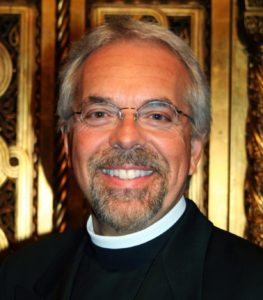
Fr Frank Marangos
Source: Oinos Educational Consulting
by Frank Marangos, D.Min., Ed.D., FCEP
The nineteenth year of the 21st Century marks a number of salient scientific milestones. On Saturday, July 20, the United States will celebrate the 50th anniversary of the historic Apollo 11 moon landing. 2019 will also commemorate the 500th anniversary of Leonardo di Vinci’s death, the man responsible for the first scientific studies of flight. The United Nations has also designated the current year as the sesquicentennial (150th) anniversary of the Periodic Table of Elements created by Dmitri Mendeleev. Little did these creative thinkers know that their valuable scientific contributions would ultimately be used to place mankind’s footprints on the surface of the moon!
The Apollo 11 mission fulfilled President John F. Kennedy’s dream of landing a man on the moon by the end of the decade. The young president’s vision embodied the aspirations of Di Vinci, Mendeleev and other thought leaders after them. The grand ambition was realized when at precisely 10:56 P.M., astronaut Neil Armstrong stepped onto the lunar surface and uttered his now-famous line: “One small step for man, one giant leap for mankind.” While the media will frequently repeat the epic quote, America’s insufficient response to earth’s societal problems of poverty and homelessness tragically illustrate that mankind’s philanthropic “small steps” have, unfortunately, not kept pace with its aspirational planetary “giant leaps.”
The 50th Anniversary of America’s lunar achievement should be modulated by modestly recalling the events surrounding NASA’s 3rd intended moon walk. Notably memorialized in the 1995 film of the same name, the mission of Apollo 13 (April 13, 1970) was aborted after an oxygen tank explosion precipitated Astronaut Jim Lovell’s terrifying message: “Houston . . . we have a problem!” Notwithstanding great hardships caused by limited power, loss of cabin heat, shortage of potable water, and repairs to the carbon dioxide removal system, the space craft miraculously returned safely home, largely due to the crew’s trust in the perseverance, advice, and creative ingenuity of NASA’s Mission Control Center.
Safely back home on earth, engineers discovered that damaged electrical wiring and faulty adjustments made over a five-year period to the oxygen tank thermostat actually caused the catastrophic explosion. No one knew it, but when the Saturn rocket lifted off, it carried within it a small but lethal time-bomb. In a poignant scene in the Apollo 13 film, a box of unrelated items is spilled on a work table in front of a group of concerned NASA scientists. They are told that a solution to the increasing carbon monoxide poison could only be devised by using materials that were currently found in the disabled spaceship. Despite working within a life-threatening time constraint an ingenious intervention was miraculously fabricated.
Like Apollo 13, America has a major problem . . . and it’s called homelessness! A 2015 Report of Habitat for Humanity International indicates that as many as 1.6 billion people throughout the world lack adequate housing. The 2018 Annual Report of the National Alliance to End Homelessness indicates that, on any given night, more than 552,830 people are experiencing homelessness in America. While the globe’s numerous space programs have dramatically increased the likelihood of colonizing planets beyond the Moon, the United Nations laments that we still do not understand how to effectively join the requisite components to deal with the 100 million people struggling to find their way to a home right here on earth. “Homelessness,” states the 2015 General Assembly of the United Nations, “is a human rights crisis that demands an urgent global response.”
Overcoming inexorable difficulties to put a man on the moon and assist a seriously disabled spacecraft to return safely home were the result of intelligence, creativity, teamwork, and determination. Apart from national pride, these cherished virtues should inspire the nation’s faith-based organizations, nonprofit, and governmental agencies to believe that, working together, they too can also solve many of our earth-bound societal problems, specifically, homelessness. To effectively disarm the faulty societal wiring that has exacerbated the global explosion of homelessness, however, the same requisite political, creative, intellectual, and stalwart budgetary capacities deployed by NASA will be essential.
What is homelessness? What are its root causes and contributing factors? And, how can the nation’s religious, nonprofit, and governmental agencies minimize its deleterious consequences?
Definition
The U.S. Department of Health and Human Services (HHS) defines a homeless individual as “an individual who lacks housing (without regard to whether the individual is a member of a family), including an individual whose primary residence during the night is a supervised public or private facility (e.g., shelters) that provides temporary living accommodations, and an individual who is a resident in transitional housing” (Section 330, Public Health Service Act). The U.S. Department of Housing and Urban Development (HUD) refines HSS’s official definition of homeless by delineating the following four broad categories:
- Literally Homeless. People who are living in a place not meant for human habitation, in emergency shelter, in transitional housing, or are exiting an institution where they temporarily resided.
- Imminent Risk of Homelessness. People who are losing their primary nighttime residence, which may include a motel or hotel or a doubled-up situation, within 14 days and lack resources or support networks to remain in housing.
- Homeless Under Other Federal Statutes. Families with children or unaccompanied youth who are unstably housed and likely to continue in that state.
- Fleeing/Attempting to Flee Domestic Violence. People who are fleeing or attempting to flee domestic violence, have no other residence, and lack the resources or support networks to obtain other permanent housing.
- Living without a shelter of any kind, sleeping rough.
- Living with a place to sleep but temporary in institutions or shelter.
- Living in Insecure Housing. Living under the threat of severe exclusion due to insecure tenancies, eviction, and/or domestic violence.
- Living in Inadequate Housing. Living in caravans on illegal campsites, in unfit housing, in extreme overcrowding.
Housing First
The National Alliance to End Homelessness (NAEH), a nonpartisan organization committed to preventing and ending homelessness in the United States, corroborates the research conclusions of ASPE by advocating that “a community-wide coordinated approach to delivering services, housing, and programs is needed to solve America’s homeless crises.” The Research conducted by the Alliance underscores the fact that the essential first step solution to the problem is housing. Housing First programs share four critical elements:
- There is a focus on helping individuals and families access and sustain rental housing as quickly as possible and the housing is not time-limited;
- A variety of services are delivered primarily following a housing placement to promote housing stability and individual well-being;
- Such services are time-limited or long-term depending upon individual need; and
- Housing is not contingent on compliance with services – instead, participants must comply with a standard lease agreement and are provided with the services and supports that are necessary to help them do so successfully (NAEH).
The National Registry of Evidence-Based Programs and Practices (NREPP), a repository of reliable information on mental health, substance abuse, and interventions to serve the homeless, supports the Home First Model recommendations of ASPE and NAEH. By advancing a Housing First Model, the homeless are given a platform from which they can address other areas that may have contributed to their unfortunate situation, namely, unemployment, physical and mental illness, domestic violence, and substance abuse.
Housing First and Housing-Plus-Services Models are based on the theory that client choice is valuable in the selection of shelter and the subsequent participation in supportive services. Affording the homeless to exercise this choice contributes to the likelihood that the client will be more successful in remaining housed and improving their life conditions. According to Dr. Sam Tsemberis, founder of the Housing First approach and recipient of the American Psychiatric Association’s (APA) Community-Based Program Award, “the model is simple: provide housing first and then combine that housing with supportive services” (Housing First Manual, 2015). This client-based approach begins with alleviating the immediate needs of the homeless and then assisting them to identify their goals and interventions.
NREPP advocates two Home First Models that have demonstrated the ability to effectively reduce the ill effects of homelessness. They are:
- Permanent Supportive Housing (PSH): Permanent supportive housing pairs long-term rental assistance with supportive services. It is targeted to individuals and families with chronic illnesses, disabilities, mental health issues, or substance abuse disorders who have experienced long-term or repeated homelessness.
- Rapid Re-Housing (RRH): Rapid re-housing provides short-term rental assistance and services. The goals are to help people obtain housing quickly, increase self-sufficiency, and stay housed.
Housing-Plus-Services
The Housing-Plus-Services Model suggests that once stable housing has been established, case management services should be offered to individuals and families experiencing homelessness. The National Association of State Mental Health Program Directors (NASMHPD) defines case management as “a range of services provided to assist and support individuals in developing their skills to gain access to needed medical, behavioral health, housing, employment, social, educational, and other services essential to meeting basic human services.” This also includes providing “linkages and training for the patient served in the use of basic community resources, and monitoring of overall service delivery.”
Case managers work with people and families experiencing homelessness and those who are at risk of homelessness. Case managers are critical for screening and identify households of greatest risk and determine the type of support needed to prevent homelessness. They also help clients develop independent living skills, provide support with treatment, and serve as the point of contact between clients and people in their social and professional support systems. Only by maintaining a case management protocol can interventions such as Trauma Recovery Integration (ATRI), Motivational Interviewing (MI), Assertive Community Treatment (ACT), Critical Time Intervention (CTI), and Supported Employment be appropriately chosen for each client.
Fifty years ago humanity left footprints on the surface of the moon. What happened before these first steps were permanently impressed in the lunar soil is equally inspiring. Apart from its scientific contribution, Apollo 11 marked the first liturgical celebration of the Holy Eucharist on a planet other than the Earth. Before Neil Armstrong took his first steps, astronaut Buzz Aldrin privately observed the Christian Sacrament of Holy Communion using pre-sanctified elements he had brought with him on the mission.
Aldrin began the brief liturgical observance with the following scriptural reading from the Gospel of Saint John: “I am the vine, you are the branches. Whosoever abides in me will bring forth much fruit. Apart from me you can do nothing” (15:5). In so doing, Aldrin memorialized humanity’s communal responsibility and its fellowship with the Creator of its two homes – one on earth, and the one that would be newly inaugurated.
The 50th anniversary of mankind’s epic landing on the moon provides an opportunity to simultaneously probe issues surrounding an important moral question. What are the footprints that America is leaving on the soul of the nation’s most pressing epidemics – homelessness? Will they embody a systemic approach that includes the spiritual . . . mystical and sacramental? Or will the footprints merely personify the political, physical, and psychological aspects of how we define HOME?
If we can land astronauts on the surface of moon and bring them back safely again . . . then nothing should curb our ability to help the world’s shelterless find their way to a suitable home. Future generations will assess the achievements of the 21st Century according to the extent of humanity’s philanthropic vision in service of this most pressing global problem.




2 Comments
Thanks Fr Frank for enlightening us on this unknown fact of communion on the moon!
Fr Frank, at first I thought you were going to give us some new ecclesiastical reason why it was important to “land on the moon” and I was so glad you didn’t go there! I think we Orthodox need to really take the homeless and hungry to heart and use our great Cathedral churches and Festival areas to feed the homeless. There are few Orthodox churches that do this and many have the means. Priests and laity, can we please get together and feed people on holidays or other days of some significance? Normally, St George Orthodox Church in Houston feeds 500 people in their church hall at Christmas. Nearby Orthodox churches with huge kitchens and grounds don’t seem to catch on, that this is also God’s work. If you need help organizing, please take advantage of many organizations that can help like Feeding North America. As the end of the “Pandemic” hopefully draws near, let’s make the plan to do this in 2021. If we can feed people at festivals, we can surely feed people for the good of God at other times of the year as well. I am making a point to participate this year and hope others will put this on their list. Thanks for the great article Father Frank, God bless you and Presbytera Heidi!
Matthew 26:11 “You will always have the poor among you, but you will not always have me.”